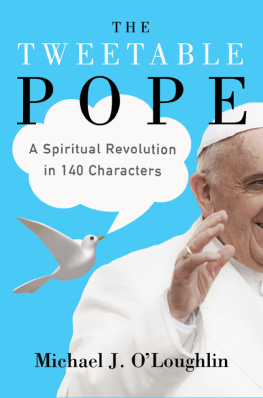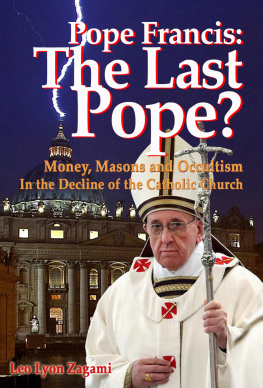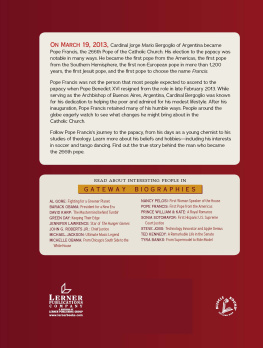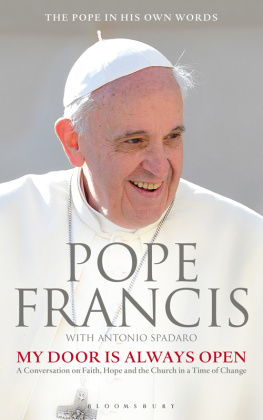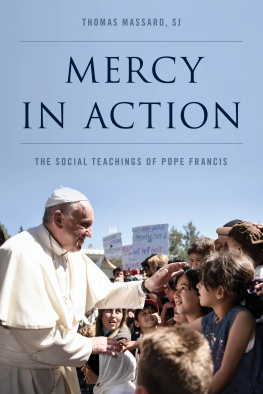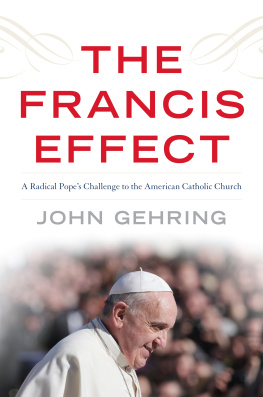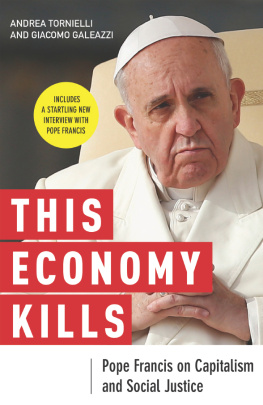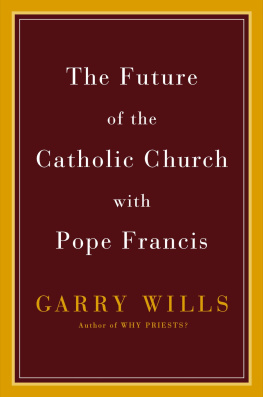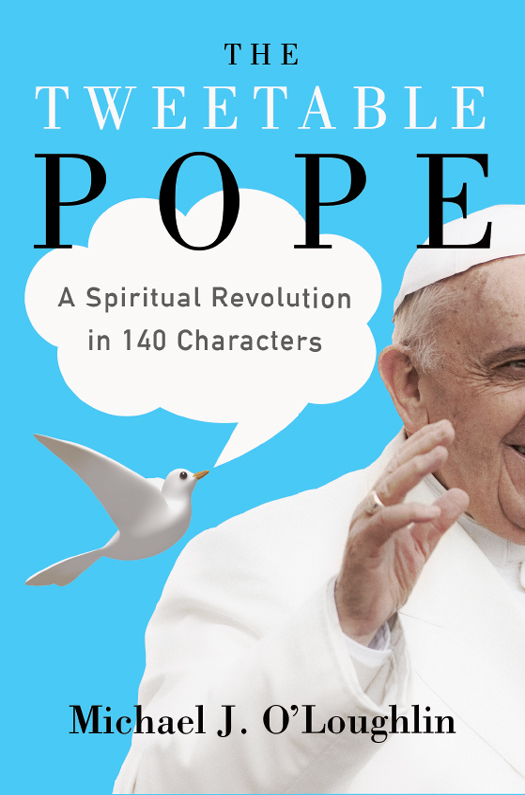To my mom, dad, and Matt: Thank you.
CONTENTS
Guide
POPE FRANCIS IS A ROCK STAR. RECORD NUMBERS OF pilgrims fill Saint Peters Square each week for his general audience. His papal visits attract millions, all hoping for a glimpse of this septuagenarian Argentine dressed in a fraying white cassock. Babies are handed to him and police barricades stand no chance. And oh that swag: Pope Francis bobbleheads, T-shirts, and even plush toys. Everyone wants a piece of this pope. Hes been featured on a wide range of magazine covers: The New Yorker, The Advocate, Fortune, Rolling Stone, and, of course, Time, as their Person of the Year. The media and the public hang on every word, looking for clues about where he intends to lead the Church. Catholics and other Christians, fascinated by Francis, want to know how they might apply some of his lessons to their own lives.
The pope, nearly eighty, has admitted he cant really work a computer. He communicates with his top cardinals via fax machine. And he leads an institution that still uses smoke signals to communicate its most important news. At first glance, Francis may seem like an out-of-date leader for a haplessly ancient institution, at least when it comes to communication. But dig a little deeper, and the key to understanding this fascinating figure and his vision for the Church is found in a decidedly modern place: Twitter.
Using his @Pontifex account, Pope Francis communicates ancient truths, spiritual insights, and bursts of wisdom instantly to his millions of followers. And with the highest re-Tweet ratefollowers publishing his messages for their own followers to readamong global leaders, Pope Francis has a platform to spread his spiritual revolution further than any pope before. The pope is able to reach out directly to his people. Its the perfect platform for Francis as he tries to revitalize the Church, one believer at a time.
For those unfamiliar with Twitter, heres a crash course: Twitter is a social network, where users create free profiles to connect with friends and family, as well as journalists, celebrities, politicians, and now even popes. An estimated 300 million users publish thoughts, ideas, or links to websites. Those messages, called Tweets, are limited to 140 characters, and close to 6,000 Tweets are published each second of the day, every dayyes, you read that right: 6,000 per second.
Some people dismiss Twitter because of the limit to the number of characters allowed per thought. There cant be much deep thinking going on, they say. But critics miss the point. Figuring out how to distill a complex message down to the essentials, to capture someones attention in a busy, rushed world, and to convince them to consider how they live their lives is a lot more difficult to do in a few words than it is in an essay or op-ed. But do it well, and you will leave your audience with something powerful to reflect on throughout the day. Do it really well, and you might even change the world.
Still not convinced? Lets take some of Jesuss most powerful teachings. Too deep for Tweets, right? Hardly. Blessed are the poor in spirit, for theirs is the kingdom of Heaven. At a mere 68 characters, theres still plenty of room for a couple of hashtags. (If you are shaking your head over the term hashtag, these are what Twitter uses to categorize Tweets and are designated by adding a pound sign [#] in front of a term. So if someone wants to search an established theme or an event, they could search by the hashtag.) For this beatitude, maybe #PoorHereRichThere would work with that little slice of Jesuss sermon.
Let anyone among you who is without sin be the first to throw a stone at her. Just 77 characters. I am the way, and the truth, and the life. No one comes to the Father except through me. Only 88 characters. I give you a new commandment, that you love one another. Just as I have loved you, you also should love one another. At 116, still well below Twitters maximum of 140 characters. You get the idea. Putting our deepest thoughts into pithy, memorable phrases takes skill, talent, and a deep knowledge of the subject at hand. The rewards can be immeasurable. People remember, reflect, and, hopefully, change their lives in response.
Pope Francis is masterful at this. Hes dusting off antiquated parchment and presenting Jesus in a way thats more accessible to the digital generation. His informal but official homilies are known for how they speak to people where they are. Hes able to make the seemingly ordinary experiences of everyday life seem graced and meaningful. He does the same on Twitter, connecting with millions around the world, asking them to pause a moment during their hectic lives and consider something deeper. His Tweets connect people to God, by pointing them to moments of grace and showing them the way God calls us each to live. Even limited to 140 characters, the popes Tweets play a powerful role for his followers.
Speaking of followers, the number of followers someone has is how others assess a leaders influence. As of this books printing, the worldwide leader for English-language Tweeting is Katy Perry, followed closely by Justin Bieber, with each being followed by more than 64 million people. On that list Pope Francis, as of this writing, comes in at 260 with 6.4 million followers. But Pope Francis is not limited to English. He Tweets in several languages. His combined total is more than 21 million people. While well shy of pop stars, lets think about that number for a moment. When in history has a pope ever been able to communicate directly to 21 million people at a time? Before television, the answer would be never. Even with television, the answer would be very rarely. This pope reaches 21 million people, on average, four to five times a week.
The number of followers who re-Tweet the popes messages means many times the popes followers read what he has to say, spend some time with it, and maybe even feel a bit closer to God. On Twitter, each follower has the ability to re-Tweet a post to his or her own followers, thus multiplying the reach and impact of a particular Tweet. Since Franciss posts are re-Tweeted at such a high rate, some of his short sermons can reach as many as 200 million people. And the popes Twitter impact doesnt stop online. Italian news stations use the popes Tweets in scrolling tickers at the bottom of the screens. English-language media outlets report regularly on the popes sharpest Tweets, as you will see perhaps most clearly in the chapter on inequality. And I cant even count the number of times friends and colleagues have included in a conversation, Did you see what the pope Tweeted?
Surprisingly, Pope Francis has a large number of followers in Saudi Arabia, the United Arab Emirates, and other Gulf states. At first, the Vatican was perplexed. With churches illegal in some of those nations, there arent a whole lot of Christians in the region. While many Muslims respect Pope Francis, polls show most have no opinion of him. So why the huge following? The popes Twitter team dug around and realized most of the followers in the Gulf states werent curious Muslims, but Filipinos who had immigrated to the Middle East to find work.
Many of those workers live grueling lives: corrupt bosses who withhold wages, dangerous and abusive working conditions, and sometimes even outright physical abuse that activists say constitutes modern-day slavery. On top of all that, they sometimes cant practice their faith openly. Even reading a Bible could be dangerous. But rather than lose their faith, they log on to Twitter and follow the pope. Its a way for them to be connected to the Church, their culture, and even a sense of home. So even though Twitter has more than its fair share of mundane celebrity ramblings and trolls intent on spreading hate, its also a powerful way to practice ones faith, even in the most trying of circumstances. For the Filipino worker stationed in Riyadh, with no church or Christian community, Twitter isnt a distraction or waste of time. Its a tool to connect with the divine.

